Termite larvae don’t pose health risks to humans, but they are very destructive pests. Just like adult termites, these baby termites also feed on cellulose or wood pulp and cause huge structural damage to property. Therefore, they should be eradicated as soon as identified.
What do termite larvae look like? Termite larvae resemble their adult version, except that they are smaller. Nevertheless, they have no hard outer shells as compared to adult termites. Also called baby termites, these juvenile termites don’t have wings yet. They may also be confused with maggots (fly larvae).
Just like bed bugs, lice, and roaches, termites also undergo metamorphosis. They pass through three life cycle stages – the egg, the larval (immature), and the adult stage. This article will help you know this pest better, specifically the termite larvae, including their feeding habits, habitat, and behavior.
What Are Termite Larvae?
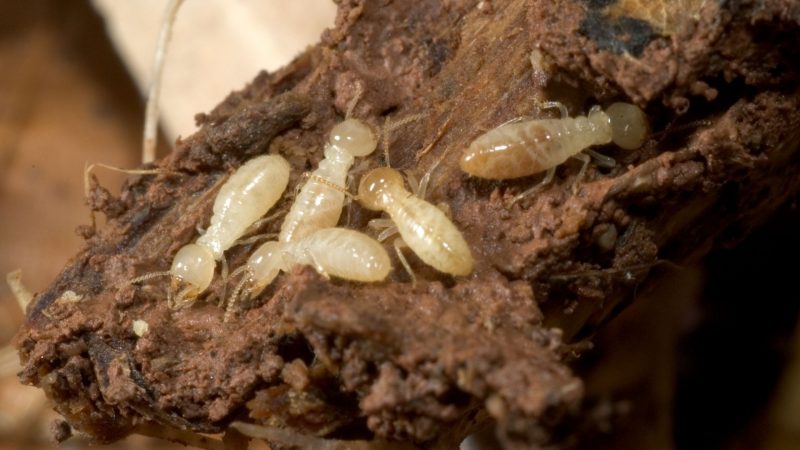
Termite larvae are newly hatched termites and are in the development stage of termites. Under normal weather conditions, termite eggs can hatch into larvae between 26 and 30 days. During their growth period, termite larvae will molt several times and will shed their skins (exoskeleton) every molting period.
As termite larvae reach their nymph stage, they can either become workers, soldiers, or reproductive termites (called alates), depending on the needs of their colony. However, most of them (males and females) will remain as workers. On the other hand, some of them will develop their wings as they become adults.
What Do Baby Termites Look Like?
Baby termites are translucent and usually white, just like nymphs, workers, and adults. They have a segmented, distinctive head, a pair of very small, straight antennae, and six legs. However, they don’t have eyes, and therefore, they are blind. Interestingly, only the reproductive termites (kings and queens) have eyes.
How Big Are Termite Larvae?
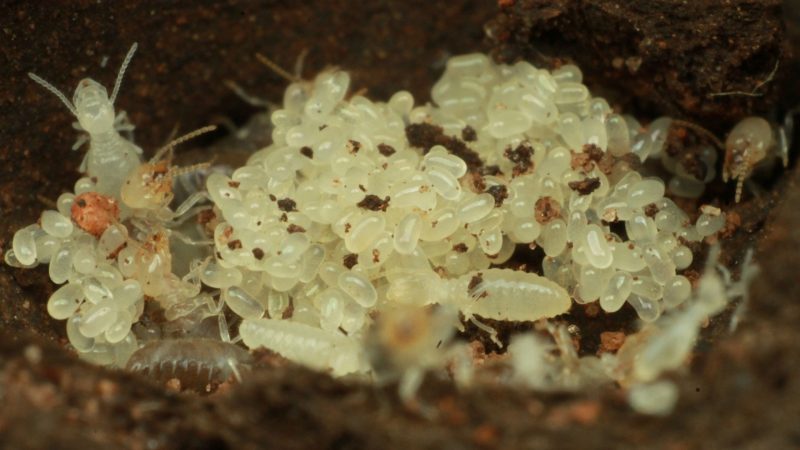
On average, termite larvae are about 1/10 inch (2.54 mm) long and can be as small as termite eggs, where they emerged from. Therefore, you may not see them clearly with your naked eyes. Nevertheless, these baby termites can grow between 1/4 and 3/8 inch (6.35 and 9.5 mm) long once they become alates.
Do Termite Larvae Look Like Maggots?
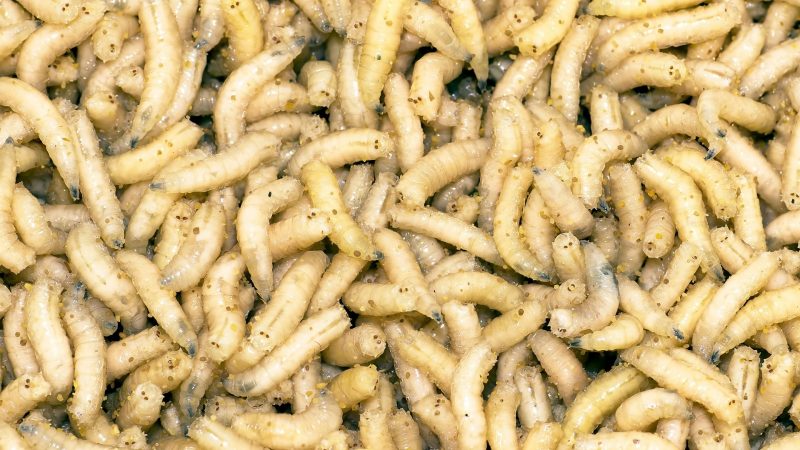
Termite larvae look like maggots. Both of them have soft, white bodies and have no outer shells. However, maggots, which would later become flies, have no legs. Sometimes, they can also be light brown or yellowish. Meanwhile, if you take a closer look at termite larvae, you will notice that they have very tiny legs.
Aside from that, you can hardly see the head of a maggot, as it’s very small and is almost invisible. This is because it is completely hidden within their thorax. On the other hand, termite larvae have a segmented head, and you can easily recognize it. And again, they look like a miniature version of adult termites.
Where Can Termite Larvae Be Usually Found?
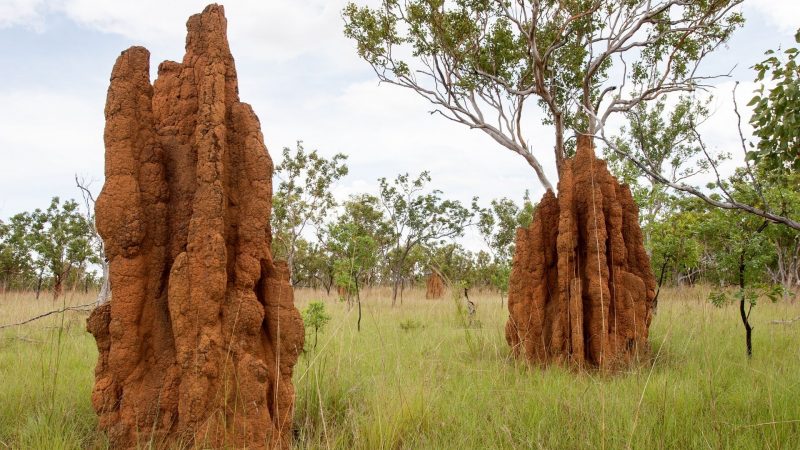
Subterranean termite larvae are usually found under the soil, where the workers build their nest, and the queen lays her eggs. The nest is made out of saliva and feces, along with mud. These underground termite nests can be 18 – 20 feet (5.5 – 6 meters) deep and serve as protection against predators, and extreme weather, and as a moisture reservoir for their colony. Additionally, subterranean termites are the most destructive ones out of their 2,750 kinds.
On the other hand, dry wood termite larvae are found in sound, dry wood above the ground, where they nest and take care of their young. This includes dead trees, utility poles, structural lumber, wooden fences, stored lumber, and wooden furniture. Unlike subterranean termites, drywood termites don’t live in the soil.
Meanwhile, some termite species in hot countries such as Africa and Australia can create a very tall nest, also called termite mounds. They can be as high as 20 feet (6 meters). Nevertheless, you are very unlikely to see termite mounds in the US.
Related: How to Get Rid of Subterranean Termites? | Control and Prevention
Do Termite Larvae Move Fast?
Termite larvae don’t move fast simply because they are still too young. In fact, they almost cannot be moved and spend most of their time in a colony. These baby termites also cannot digest their food yet, and they still need lots of help. Therefore, the bigger and faster termite workers will crush the food for them.
How Long Do Termites Larvae Live?
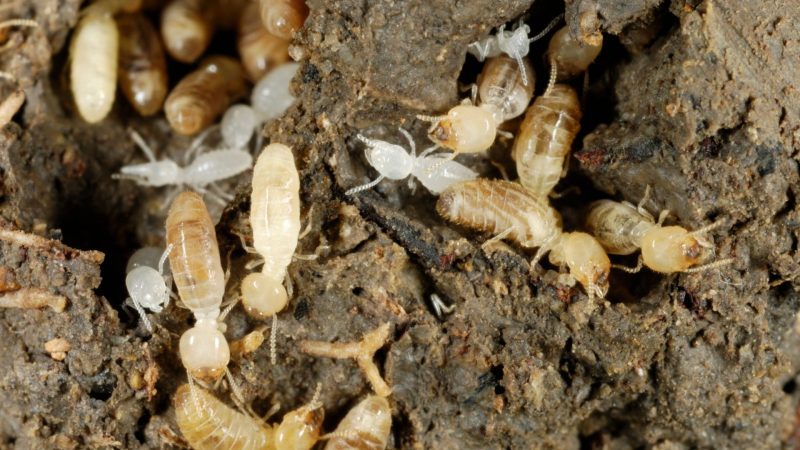
Termite larvae live until they become alates, and this transition may take 3 – 4 months. Typically, termite workers will mature within a year and may live from 3 to 5 years. Meanwhile, termite soldiers can also mature within a year and may live up to 5 years. But amazingly, queen termites can live up to 25 years.
How to Get Rid of Termite Larvae?
Subterranean termites and dry wood termites have different places in their nests. Therefore, the techniques to get rid of termite larvae depend on where they are. If you use the wrong methods, you will not get positive results. Instead, termite larvae will grow into adults, and you can expect a severe termite infestation.
What to Do if You Find Termite Larvae in Your House?
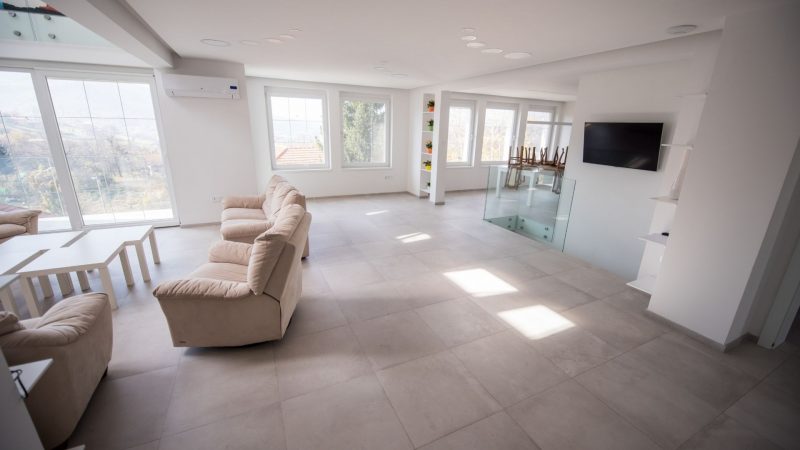
Subterranean termites may live underground, but they create mud tubes so they can crawl up and forage for food. Therefore, you may see both subterranean and dry wood termites in your house. And although you can usually find them eating wood, they also eat paper, books, and anything that contains cellulose.
Subterranean termite larvae stay underground until they become alates. On the other hand, you may find dry wood termite larvae hiding within the wooden structures of your house. You may also find workers and soldiers, dead and alive. If you see termite larvae in your house, here are some activities you should do and not do:
- Don’t panic. Analyze the situation carefully before taking any action. If you disturb the termites, they can easily escape. They may leave the area but will return later or will just transfer to another part of your house.
- Termites cannot survive in extreme heat. If your wooden furniture has some termites and there’s no infestation yet, bring it carefully outside your house. Leave it in direct sunlight for 2 – 3 days, and termites will die eventually.
- Trap the termites using moistened corrugated cardboard. Once they are attracted to it, burn the cardboard. Although this technique may look simple and effective, there’s no guarantee that all termites will be trapped.
- In some cases where extreme heat cannot reach the termites, you can try some essential oils such as orange oil and wintergreen oil. However, they only work against dry wood termites and may damage your furniture.
- Most DIY (Do-It-Yourself) strategies are effective in getting rid of termites if there are only a few of them. But if the infestation is severe, you cannot solve the problem alone. You may need help from termite experts.
How Do You Kill Termite Larvae in Soil?
As mentioned above, termites that live underground belong to the subterranean species. Therefore, you cannot get rid of subterranean termites in the soil using the same methods used to eliminate dry wood termites. Nevertheless, here are some ways to get rid of termite larvae that are hiding under the ground:
1. Apply a Liquid Pesticide
Also called termiticides, liquid pesticides are effective in repelling and eliminating subterranean termites that will try to enter your house. However, you need lots of them for your house perimeter. Most of the time, drilling or trenching is a must. Also, some states ban the use of termiticide because of its high toxic levels.
- TERMITE KILLER: Easy to use granuals kills the termites you see,...
- PERIMETER DEFENSE: Treat around the perimeter of your home,...
- EASY APPLICATION: Just sprinkle, water, and walk away
- COVERAGE AREA: Treats up to 200 linear feet- that's the...
- RESTRICTIONS: Not for sale in NY, CT, CO, MD, VT & NJ
2. Install Termite Bait System
A termite bait system requires a mixture of cellulose and a slow-acting insecticide as bait to get rid of subterranean termite larvae and alates. Here, the purpose is for the termite workers to consume the bait and share it with other members of the colony. However, not all termites will find the bait, and you may need many bait systems.
Note: Both of these methods are effective in eliminating termite larvae in the soil. However, they may only work in mild cases. In severe cases, it’s better to hire termite experts because they have the right equipment and they know the right termiticide to use. Hence, the percentage of getting better results is also higher.
- Shipping Restriction states: AK, CA, CT, DC, HI, IN, ME, MI, NY,...
- We are unable to ship products to specific states due to state...
- Description: This bait goes only with Advance baiting systems,...
- Target Pests: Termites. Follow label for all listed pests.
- Shelf life: Trelona Bait Station can last between 60 to 120 days...
What Are the Natural Deterrents for Termites?
Aside from direct sunlight, there are other natural ways to repel termites or get rid of them. Although all of them are safe and effective, you may need to use them repeatedly to achieve better results. Also, they may not be as effective as you would expect if the termite infestation is severe. Anyway, here are some of them:
- Beneficial nematodes (may not be effective in structures)
- Boiling water
- Essential oils
- Sand barriers
- Salt solution
Related: How Much Does Termite Treatment Cost? | A Detailed Guide
List of Sources
Termite Biology (Eastern Subterranean Termites and Formosan Termites). Mississippi State University.
Lewis, V., et al. (2014). How to Manage Pests of Homes, Structures, People, and Pets: Subterranean and Other Termites. University of California.
Termites. NC State University.
Extension Entomology: Drywood Termites. Texas A&M University.
Kamble, S. (1991). EC91-1556 Subterranean Termites and Their Control. University of Nebraska – Lincoln.
- How to Get Rid of Cockroaches? | Proven Strategies & Solutions! - June 24, 2023
- Powerful Homemade Wasp and Bee Sprays (with Recipes) - March 4, 2023
- Crazy Ants Invasion | Eradicate & Prevent Unwanted Guests - February 24, 2023


